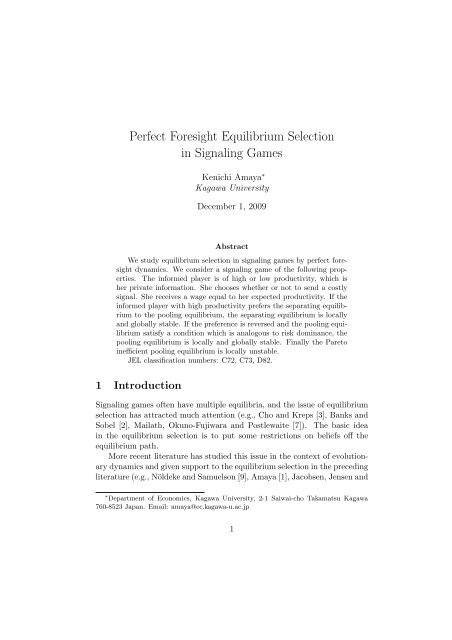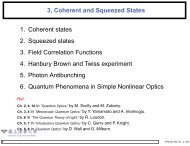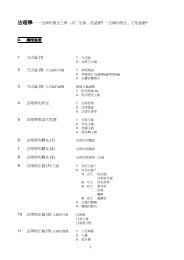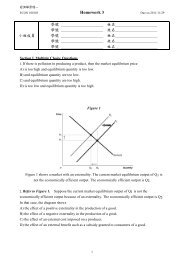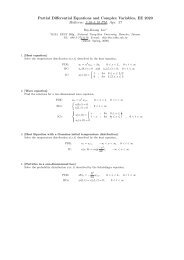Perfect Foresight Equilibrium Selection in Signaling Games
Perfect Foresight Equilibrium Selection in Signaling Games
Perfect Foresight Equilibrium Selection in Signaling Games
You also want an ePaper? Increase the reach of your titles
YUMPU automatically turns print PDFs into web optimized ePapers that Google loves.
<strong>Perfect</strong> <strong>Foresight</strong> <strong>Equilibrium</strong> <strong>Selection</strong><br />
<strong>in</strong> Signal<strong>in</strong>g <strong>Games</strong><br />
Kenichi Amaya ∗<br />
Kagawa University<br />
December 1, 2009<br />
Abstract<br />
We study equilibrium selection <strong>in</strong> signal<strong>in</strong>g games by perfect foresight<br />
dynamics. We consider a signal<strong>in</strong>g game of the follow<strong>in</strong>g properties.<br />
The <strong>in</strong>formed player is of high or low productivity, which is<br />
her private <strong>in</strong>formation. She chooses whether or not to send a costly<br />
signal. She receives a wage equal to her expected productivity. If the<br />
<strong>in</strong>formed player with high productivity prefers the separat<strong>in</strong>g equilibrium<br />
to the pool<strong>in</strong>g equilibrium, the separat<strong>in</strong>g equilibrium is locally<br />
and globally stable. If the preference is reversed and the pool<strong>in</strong>g equilibrium<br />
satisfy a condition which is analogous to risk dom<strong>in</strong>ance, the<br />
pool<strong>in</strong>g equilibrium is locally and globally stable. F<strong>in</strong>ally the Pareto<br />
<strong>in</strong>efficient pool<strong>in</strong>g equilibrium is locally unstable.<br />
JEL classification numbers: C72, C73, D82.<br />
1 Introduction<br />
Signal<strong>in</strong>g games often have multiple equilibria, and the issue of equilibrium<br />
selection has attracted much attention (e.g., Cho and Kreps [3], Banks and<br />
Sobel [2], Mailath, Okuno-Fujiwara and Postlewaite [7]). The basic idea<br />
<strong>in</strong> the equilibrium selection is to put some restrictions on beliefs off the<br />
equilibrium path.<br />
More recent literature has studied this issue <strong>in</strong> the context of evolutionary<br />
dynamics and given support to the equilibrium selection <strong>in</strong> the preced<strong>in</strong>g<br />
literature (e.g., Nöldeke and Samuelson [9], Amaya [1], Jacobsen, Jensen and<br />
∗ Department of Economics, Kagawa University, 2-1 Saiwai-cho Takamatsu Kagawa<br />
760-8523 Japan. Email: amaya@ec.kagawa-u.ac.jp<br />
1
Sloth [5]). In the dynamics considered <strong>in</strong> these papers, a signal<strong>in</strong>g game is<br />
played by a population of players. The players behave <strong>in</strong> a boundedly rational<br />
way, or myopically, <strong>in</strong> the sense that when they are given an opportunity<br />
to choose an action they take a best response to the current state of all players’<br />
behavior.<br />
In the present paper, we study the perfect foresight dynamics with Poisson<br />
revision opportunities, orig<strong>in</strong>ally proposed by Matsui and Matsuyama<br />
[8]. We consider a signal<strong>in</strong>g game played between player I (<strong>in</strong>formed player,<br />
or sender) and player II (un<strong>in</strong>formed player, or receiver). Our model has a<br />
large population of player I and another large population of player II, who<br />
are repeatedly and randomly matched to play the signal<strong>in</strong>g game. Player<br />
I is endowed with a type, which is her private <strong>in</strong>formation. The type of<br />
each <strong>in</strong>dividual <strong>in</strong> the role of player I is fixed over time. Player II can<br />
switch actions at any moment and is assumed to take a best response to<br />
the current action distribution of player I. On the other hand, each player<br />
<strong>in</strong> the role of player I must make a commitment to a particular action for<br />
a random time <strong>in</strong>terval. Opportunities to revise actions follow Poisson processes,<br />
which are <strong>in</strong>dependent across players. They maximize their expected<br />
discounted payoffs. This dynamic game with frictions generates nontrivial<br />
equilibrium paths of behavior patterns, whose stationary states correspond<br />
to the sequential equilibria of the signal<strong>in</strong>g game.<br />
We consider a simple signal<strong>in</strong>g game with two types and two signals. In<br />
analogy with Spence [11], player I and II may be <strong>in</strong>terpreted as a worker<br />
and the market. The worker’s private <strong>in</strong>formation is her productivity, which<br />
may be high (type 1) or low (type 0). She chooses whether or not to send<br />
a costly signal such as education. The market pays a wage equal to the<br />
worker’s expected productivity given the observed signal. A pure strategy<br />
sequential equilbrium belongs to one of the follow<strong>in</strong>g classes: (i) A separat<strong>in</strong>g<br />
equilibrium where only the productive worker sends a costly signal and the<br />
worker receives a wage equal to her own productivity, (ii) a Pareto efficient<br />
pool<strong>in</strong>g equilibrium where the worker does not send a costly signal regardless<br />
of her type and receives a wage equal to the average productivity <strong>in</strong> the<br />
society, (iii) a Pareto <strong>in</strong>efficient pool<strong>in</strong>g equilibrium where the worker sends<br />
a costly signal regardless of her type and receives a wage equal to the average<br />
productivity <strong>in</strong> the society,<br />
We exam<strong>in</strong>e the stability of these equilibria with respect to the perfect<br />
foresight dynamics. We say a stationary state is absorb<strong>in</strong>g if all perfect<br />
foresight equilibrium with an <strong>in</strong>itial state <strong>in</strong> the neighborhood of it converges<br />
to it. A stationary state isglobally accessible if for any <strong>in</strong>itial states, there<br />
exists an equilibrium path converg<strong>in</strong>g to it. If an absorb<strong>in</strong>g state is globally<br />
2
accessible, it is the unique absorb<strong>in</strong>g state.<br />
We follow the view by Matsui and Matsuyama [8] that these two stability<br />
properties, taken together, make the unique absorb<strong>in</strong>g state a natural choice<br />
among sequential equilibria.<br />
Our result is threefold. First, if a separat<strong>in</strong>g equilibrium exists and<br />
player I with high type receives a higher payoff <strong>in</strong> it than <strong>in</strong> a Pareto efficient<br />
pool<strong>in</strong>g equilibrium, it is absorb<strong>in</strong>g and globally accessible.<br />
Second, a Pareto efficient pool<strong>in</strong>g equilibrium is absorb<strong>in</strong>g and globally<br />
accessible for sufficiently small degree of friction. if it is type-1 half dom<strong>in</strong>ant.<br />
Roughly speak<strong>in</strong>g, the type-1 half dom<strong>in</strong>ance condition means that if at<br />
least half of high type (type 1) workers do not send a costly signal and the<br />
market plays <strong>in</strong> a consistent fashion, a high type worker is better off by not<br />
send<strong>in</strong>g a costly signal. If a Pareto efficient pool<strong>in</strong>g equilibrium is type-1 half<br />
dom<strong>in</strong>ant, it is preferred by a high type (type 1) worker over the separat<strong>in</strong>g<br />
equilibrium (if any).<br />
The <strong>in</strong>tuition for this result is as follows. For simplicity consider the case<br />
where there exists a separat<strong>in</strong>g equilibrium. In this case, not send<strong>in</strong>g a costly<br />
signal is a dom<strong>in</strong>ant strategy for low type workers. By assum<strong>in</strong>g the low<br />
type workers choose not send a costly signal at every revision opportunity<br />
and the market always take a best response, we can reduce the analysis<br />
to a game played by a s<strong>in</strong>gle population of player I. Roughly speak<strong>in</strong>g,<br />
type-1 half dom<strong>in</strong>ance means that not send<strong>in</strong>g a signal is the risk dom<strong>in</strong>ant<br />
strategy (Harsanyi and Selten [4]) of this reduced form game. Here works<br />
a similar argument to Matsui and Matsuyama [8], who showed that <strong>in</strong> a<br />
s<strong>in</strong>gle population perfect foresight dynamic the risk dom<strong>in</strong>ant equilibrium<br />
is absorb<strong>in</strong>g and globally accessible for sufficiently small degree of friction.<br />
Third, a Pareto <strong>in</strong>efficient pool<strong>in</strong>g equilibrium is not absorb<strong>in</strong>g.<br />
The paper is organized as follows. In Section 2 we describe the signal<strong>in</strong>g<br />
game. In Section 3 we characterize the equilibria of the signal<strong>in</strong>g game.<br />
In Section 4 we review the exist<strong>in</strong>g literature on equilibrium selection <strong>in</strong><br />
signal<strong>in</strong>g games and exam<strong>in</strong>e how these ideas apply to our model. In Section<br />
5 we <strong>in</strong>troduce the model of perfect foresight dynamics and describe the<br />
stability concepts. In Section 6 we present the stability results.<br />
2 Signal<strong>in</strong>g game<br />
The signal<strong>in</strong>g game G is described as follows. There are two players, I and<br />
II. Player I is endowed with a type θ ∈ Θ ≡ {0, 1}. The prior probability<br />
distribution of types is common knowledge, with probability of θ = 0 given<br />
3
y 1 − p and probability of θ = 1 by p. Player I, know<strong>in</strong>g this type chooses a<br />
message m from the set M = {m0, m1}. Player II see<strong>in</strong>g m, responds with<br />
a choice r from the set R = [0, 1]. The payoff for type θ of player I for the<br />
pair of moves (m, r) ∈ M × R is given by u(m, r, θ). The payoff to player II<br />
when I is of type θ and (m, r) is chosen is given by v(m, r, θ).<br />
The payoff functions considered here take the follow<strong>in</strong>g form;<br />
<br />
rv if m = m0<br />
u(m, r, θ) =<br />
(1)<br />
rv − cθ if m = m1<br />
v(m, r, θ) = −(r − θ) 2 , (2)<br />
where v, c0 and c1 are positive constants with c0 > c1.<br />
This payoff specification follows the formulation of job market signal<strong>in</strong>g<br />
by Spence [11]. In Spence’s <strong>in</strong>terpretation, player I is a worker seek<strong>in</strong>g for a<br />
job and player II is a reduced representation of the market. Worker (player<br />
I) of type 0 (low type) has marg<strong>in</strong>al productivity 0 and type 1 has marg<strong>in</strong>al<br />
productivity v. Worker receives wage rv from the market (player II). Worker<br />
<strong>in</strong>curs a cost for send<strong>in</strong>g higher signal (m1) such as higher education, while<br />
lower signal (m0) is costless. The cost of send<strong>in</strong>g higher signal is higher for<br />
low type than high type. S<strong>in</strong>ce the wage for a worker should be equal to<br />
his expected marg<strong>in</strong>al productivityunder Bertrand competition, player II’s<br />
objective is assumed to be m<strong>in</strong>imazation of the difference between them.<br />
Player II’s payoff function follows from the fact that worker’s productivity<br />
is θv and wage is rv.<br />
Player II will never randomize <strong>in</strong> any equilibria from concavity of v, while<br />
player I may randomize. The set of all probability distributions on a set X<br />
is denoted ∆X. Player I’s mixed strategy is denoted µ : Θ → ∆M. Player I<br />
of type θ sends message m with probability µ θ (m). Player II’s pure strategy<br />
is denoted ρ : M → R.<br />
We write β : M → [0, 1] for II’s belief upon observ<strong>in</strong>g m, so that β(m)<br />
is II’s conditional belief that player I is of type 1 when he observes m ∈<br />
M. F<strong>in</strong>ally, we let BR : M × ∆T → R denote the best response to m<br />
given β(m)<br />
<br />
(which is unique from the concavity of v), i.e., BR(m, β(m)) =<br />
arg maxr∈R θ∈Θ v(m, r, θ)β(θ|m).<br />
Def<strong>in</strong>ition 1 σ = (µ, ρ, β) is a sequential equilibrium if<br />
1. For all θ ∈ Θ and m ∈ M, µ θ (m) > 0 implies m ∈<br />
arg maxm ′ ∈M u(m ′ , ρ(m ′ ), θ).<br />
2. For all m ∈ M, ρ(m) = BR(m, β(m));<br />
4
3. For all m ∈ M,<br />
β(m) =<br />
if the denom<strong>in</strong>ator is positive.<br />
pµ 1 (m)<br />
(1 − p)µ 0 (m) + pµ 1 (m)<br />
We denote the set of sequential equilibria for game G by P SE(G). With<br />
an abuse of notation we write u(σ, θ) for type θ’s payoff associated with an<br />
equilibrium σ.<br />
3 Equilibria<br />
This section characterizes all equilibria of game G.<br />
Obviously, <strong>in</strong> any equilibrium ρ(m) = β(m) for all m.<br />
Any equilibrium should belong to one of the follow<strong>in</strong>g five categories.<br />
1. Separat<strong>in</strong>g (σ S ): Player I of type 0 sends m0 and type 1 sends m1.<br />
2. Pool<strong>in</strong>g on m0 (σ P 0 ): Player I of both types sends m0.<br />
3. Pool<strong>in</strong>g on m1 (σ P 1 ): Player I of both types sends m1.<br />
4. Semi-pool<strong>in</strong>g on m0 (σ SP 0 ): Player I of type 0 sends m0 and type 1<br />
mixes between m0 and m1.<br />
5. Semi-pool<strong>in</strong>g on m1 (σ SP 1 ): Player I of type 0 mixes between m0 and<br />
m1 and type 1 sends m1.<br />
For each class of equilibrium, the conditions that payoff parameters must<br />
satisfy for existence of equilibrium and the equilibrium payoffs for each type<br />
are as follows.<br />
Separat<strong>in</strong>g<br />
In a separat<strong>in</strong>g equilibrium, ρ(m0) = β(m0) = 0 and ρ(m1) = β(m1) =<br />
1. The <strong>in</strong>centive conditions for player I of each type are 0 ≥ v − c0 for<br />
type 0 and v − c1 ≥ 0 for type 1. Therefore, a separat<strong>in</strong>g equilibrium exists<br />
if and only if c1<br />
c0<br />
v ≤ 1 ≤ v . The equilibrium payoffs are u(σS , 0) = 0 and<br />
u(σS , 1) = v − c1.<br />
Pool<strong>in</strong>g on m0<br />
When player I of both types sends m0, ρ(m0) = β(m0) = p. The <strong>in</strong>centive<br />
condition for player I of type θ is pv ≥ β(m1)v − cθ. This condition<br />
5
is satisfied for a belief β(m1) with 0 < β(m1) < p + c1 , and such a belief<br />
v<br />
is consistent because m1 is off the equilibrium path. Therefore, a pool<strong>in</strong>g<br />
equilibrium on m0 always exsists. The equilibrium payoff is u(σP 0 , θ) = pv<br />
for θ ∈ {0, 1}.<br />
Pool<strong>in</strong>g on m1<br />
When player I of both types sends m1, ρ(m1) = β(m1) = p. The <strong>in</strong>centive<br />
condition for player I of type θ is pv − cθ ≥ β(m0)v. If LHS is<br />
nonnegative, the condition holds for sufficiently small β(m0) and such a belief<br />
is consistent because m0 if off the equilibrium path. On the other hand<br />
if LHS is negative, there is no β(m0) ∈ [0, 1] that satisfy the condition. The<br />
LHS is nonnegative for both types if pv − c0 ≥ 0. Therefore, a pool<strong>in</strong>g<br />
equilibrium on m0 exists if and only if c0 ≤ p. The equilibrium payoffs are<br />
v<br />
u(σP 1 , 0) = pv − c0 and u(σP 1 , 1) = pv − c1.<br />
Semi-pool<strong>in</strong>g on m0<br />
In a semi-pool<strong>in</strong>g equilibrium on m0, player I of type 1 is <strong>in</strong>different<br />
between send<strong>in</strong>g m0 and m1, while type 0 is strictly better off by send<strong>in</strong>g<br />
m0. Type 1’s payoff is v − c1 when send<strong>in</strong>g m1 because β(m1) = 1. The<br />
<strong>in</strong>difference condition for type 1 is v −c1 = β(m0)v, or equivalently, 1− c1<br />
v =<br />
β(m0). S<strong>in</strong>ce<br />
β(m0) =<br />
pµ 1 (m0)<br />
(1 − p) + pµ 1 (m0) ,<br />
0 < β(m0) < p should hold. Therefore, a semi-pool<strong>in</strong>g equilibrium on m0<br />
exists if and only if 0 < 1 − c1<br />
c1<br />
< p, i.e., 1 − p < < 1. The equilibrium<br />
v v<br />
payoff is u(σSP 0 , θ) = β(0)v = v − c1 for θ ∈ {0, 1}.<br />
Semi-pool<strong>in</strong>g on m1<br />
In a semi-pool<strong>in</strong>g equilibrium on m1, player I of type 0 is <strong>in</strong>different<br />
between send<strong>in</strong>g m0 and m1, while type 1 is strictly better off by send<strong>in</strong>g<br />
m1. Type 0’s payoff is 0 when send<strong>in</strong>g m = 0 because β(m0) = 0. The<br />
<strong>in</strong>difference condition for type 0 is vβ(m1) − c0 = 0, or equivalently, c0<br />
v =<br />
β(m1). S<strong>in</strong>ce<br />
β(m1) =<br />
p<br />
(1 − p)µ 0 (m1) + p ,<br />
p < β(m1) < 1 should hold. Therefore, a semi-pool<strong>in</strong>g equilibrium on m0<br />
exists if and only if p < c0<br />
v < 1. The equilibrium payoffs are u(σSP 1 , 0) = 0<br />
and u(σ SP 1 , 1) = β(m1)v − c1 = c0 − c1.<br />
Now we consider which equilibrium is preferred by player I of each type.<br />
6
selection.<br />
A pool<strong>in</strong>g equilibrim on m0 fails <strong>in</strong>tuitive criterion if v−c0 < pv < v−c1,<br />
or equivalently, c1<br />
c0<br />
v < 1 − p < v . It fails to be div<strong>in</strong>e if pv < v − c1,<br />
or equivalently, c1<br />
v < 1 − p. Therefore, a pool<strong>in</strong>g equilibrium fails to be<br />
div<strong>in</strong>e if and only if player I of type 1 receives higher payoff <strong>in</strong> a separat<strong>in</strong>g<br />
equilibrium. Even when this is the case, a pool<strong>in</strong>g equilibrium may or may<br />
not satisfy <strong>in</strong>tuitive criterion.<br />
A pool<strong>in</strong>g equilibrium on m1 meets <strong>in</strong>tuitive criterion and is div<strong>in</strong>e.<br />
Player I of both types is better off by send<strong>in</strong>g m0 if player II’s belief β(m0)<br />
is higher than some threshold value. Therefore, <strong>in</strong>tuitive criterion puts no<br />
restriction on β(m0). S<strong>in</strong>ce the threshold value of belief is lower for type<br />
0, div<strong>in</strong>e equilibrium requires β(m0) = 0. This belief <strong>in</strong>deed constitutes a<br />
pool<strong>in</strong>g equilibrium on m = 1.<br />
4.2 Undefeated equilibrium<br />
Mailath, Okuno-Fujiwara and Postlewaite [7] offers an alternative concept,<br />
called undefeated equilibrium, of restrict<strong>in</strong>g off-path beliefs. Their idea is<br />
that if player II observes an off-path message, it should be <strong>in</strong>terpreted as<br />
player I’s attempt to move to another equilibrium. <strong>Equilibrium</strong> σ is called<br />
to defeat equilibrium σ ′ if there is a message m which is used <strong>in</strong> σ but not<br />
<strong>in</strong> σ ′ and all types who sends m <strong>in</strong> σ receives higher payoffs <strong>in</strong> σ than <strong>in</strong> σ ′ .<br />
An equilibrium is said to be undefeated if there is no other equilibrium that<br />
defeats it.<br />
Aga<strong>in</strong>, s<strong>in</strong>ce these concepts is concerned with off-path beliefs, all separat<strong>in</strong>g<br />
equilibria and semi-poo<strong>in</strong>g equilibria <strong>in</strong> our model is undefeated.<br />
A pool<strong>in</strong>g equilibrim on m0 fails to be undefeated if pv < v − c1. In this<br />
case, a separat<strong>in</strong>g equilibrium exists and gives higher payoff to player I of<br />
type 1. S<strong>in</strong>ce only type 1 sends m1 <strong>in</strong> a separat<strong>in</strong>g equilbrium, a pool<strong>in</strong>g<br />
equilibrium on m0 is defeated by a separat<strong>in</strong>g equilibrium.<br />
A pool<strong>in</strong>g equilibirum on m1 is defeated by a pool<strong>in</strong>g equilibrium on m0<br />
becase player I of both types receives a higher payoff <strong>in</strong> the latter equilibirum<br />
and messege m0 is used only <strong>in</strong> the latter equilibrium.<br />
4.3 Evolutionary equilibrium selection<br />
There are several works, such as Nöldeke and Samuelson [9], Amaya [1] and<br />
Jacobsen, Jensen and Sloth [5], which analyze evolutionary dynamics to<br />
study equilibrium selection <strong>in</strong> signal<strong>in</strong>g games. All these papers consider a<br />
discrete model with generic payoffs to do away with semi-pool<strong>in</strong>g equilibria.<br />
9
Nöldeke and Samuelson [9] work on an evolutionary dynamic of Kandori,<br />
Mailath and Rob [6], where there are many agents <strong>in</strong> the role of player I<br />
and they meet a s<strong>in</strong>gle agent <strong>in</strong> the role of player II. Nöldeke and Samuelson<br />
[9] show that a pool<strong>in</strong>g equilibrium is stable if it is undefeated and div<strong>in</strong>e,<br />
while a separat<strong>in</strong>g equilibrium is stable if it is undefeated.<br />
Amaya [1] works on Kandori-Mailath-Rob dynamic, <strong>in</strong> which there are<br />
many agents <strong>in</strong> the role of both players and they are randomly matched.<br />
Jacobsen, Jensen and Sloth [5] work on an evolutionary dynamic of Young<br />
[12]. These papers show that Riley equilibrium (Pareto efficient separat<strong>in</strong>g<br />
equilibrium) is stable 1 .<br />
5 <strong>Perfect</strong> foresight dynamics<br />
We consider perfect foresight dynamics proposed by Matsui and Matsuyama<br />
[8].<br />
5.1 Dynamics<br />
There is a unit mass of agents <strong>in</strong> the role of player I and that of agents <strong>in</strong><br />
the role of player II. The type of each agent <strong>in</strong> the role of player I is fixed<br />
over time. Proportion 1 − p of player I agents has type 0 and proportion p<br />
has type 1. Time is cont<strong>in</strong>uous. At each po<strong>in</strong>t <strong>in</strong> time, player I and player<br />
II are randomly matched and play the signal<strong>in</strong>g game G. We assume that<br />
player I cannot switch messages at every po<strong>in</strong>t <strong>in</strong> time. Instead, every agent<br />
<strong>in</strong> the role of player I must make a comm<strong>in</strong>ment to a particular message<br />
for a random time <strong>in</strong>terval. Time <strong>in</strong>stants at which each player can switch<br />
actions follow a Poisson process with the mean arrival rate λ. The processes<br />
are <strong>in</strong>dependent across players.<br />
On the other hand, we assume that player II can revise beliefs and switch<br />
actions at any po<strong>in</strong>t <strong>in</strong> time. At any time t, each agent <strong>in</strong> the role of player<br />
II forms belief β(t) : M → [0, 1] that is consistent with player I’s actual<br />
behavior, and play strategy ρ(t) : M → [0, 1], which is optimal given β(t).<br />
We assume all agents of player II share the same belief β(t). The optimality<br />
of ρ(t) implies ρ(t)(m) = β(t)(m) for all t and m.<br />
The message distribution among type θ agents at time t is denoted by<br />
x θ (t) = (x θ (t)(m0), x θ (t)(m1)),<br />
1 The three papers mentioned here impose some assumptions on the structure of the<br />
game and thus the results mentioned here do not necessarily apply directly to our model<br />
10
and let x(t) = (x 0 (t), x 1 (t)).<br />
S<strong>in</strong>ce player II forms a consistent belief at any time, the belief β(t)<br />
satisfies<br />
β(t)(m) =<br />
px 1 (t)(m)<br />
(1 − p)x 0 (t)(m) + px 1 (t)(m)<br />
if the denom<strong>in</strong>ator is positive.<br />
We call x(t) the message state at time t. The state of the society at<br />
time t is a pair (x(t), β(t)), and we consider the evolution of the state over<br />
time. Notice if a type θ agent sends m at time t and the belief is β(t), he<br />
receives a payoff u(m, β(t)(m), θ), because ρ(t)(m) = β(t)(m). A rational<br />
player anticipates the future evolution of state (x(t), β(t)), and, if given the<br />
opportunity to switch actions, commits to an action that maximizes the<br />
expected discounted payoff. S<strong>in</strong>ce the duration of the commitment has an<br />
exponential distribution with the mean 1<br />
λ , the expected discounted payoff<br />
for type θ of commit<strong>in</strong>g to message m at time t with a given anticipated<br />
path (x(t), β(t)) is represented by<br />
V θ (t)(m) = (λ + α)<br />
= (λ + α)<br />
∞<br />
0 ∞<br />
where α > 0 is a common discount rate, and<br />
<br />
0<br />
Im =<br />
1<br />
if<br />
if<br />
m = m0<br />
m = m1<br />
0<br />
e −(λ+α)s u(m, β(t + s)(m), θ)ds<br />
e −(λ+α)s β(t + s)(m) · vds − Imcθ<br />
Endowed with perfect foresight, players correctly anticipate the future<br />
evolution of (x(t), β(t)). Hence, the messege distribution path x(t) with an<br />
<strong>in</strong>itial state (x(0), β(0)) satisfies<br />
˙x θ ⎧<br />
⎨<br />
(t)(m) ∈<br />
⎩<br />
{λ(1 − x θ (t)(m))} if V θ (t)(m) > V θ (t)(1 − m)<br />
{−λx θ (t)(m)} if V θ (t)(m) < V θ (t)(1 − m)<br />
[ − λx θ (t)(m), λ(1 − x θ (t)(m))] if V θ (t)(m) = V θ (t)(1 − m)<br />
(4)<br />
for all t where xθ (t)(m) is differentiable.<br />
F<strong>in</strong>ally def<strong>in</strong>e the degree of friction by δ = α<br />
λ > 0.<br />
11<br />
.<br />
(3)
5.2 Stability concepts<br />
We say a message state x ∗ is stationary if a path (x(·), β(·)) such that x(t) =<br />
x ∗ for all t is a perfect foresight equilibrium path for some β(·). Obviously,<br />
s ∗ is stationary if and only if there exists a belief β consistent with x(·)<br />
such that player I’s strategy represented by x ∗ and β compose a sequential<br />
equilibrium. Our analysis of equilibrium selection is to study the stability<br />
of a message state x.<br />
We use the concepts of local and global stability proposed by Matsui and<br />
Matsuyama [8]. An absorb<strong>in</strong>g state x is locally stable <strong>in</strong> the sense that all<br />
perfect foresight dynamics beg<strong>in</strong>n<strong>in</strong>g from a nearby state converge to x. A<br />
state is globally accessible if for any state x ′ there exists a perfect foresight<br />
path from x ′ converg<strong>in</strong>g to x.<br />
Def<strong>in</strong>ition 2 A message state x is absorb<strong>in</strong>g if there exists ε > 0 such<br />
that message state of any perfect foresight equilibrium path whose message<br />
state beg<strong>in</strong>s from Bε(x) converges to x. A sequential equilibrium σ of the<br />
signal<strong>in</strong>g game G is absorb<strong>in</strong>g under the perfect foresight dynamics if the<br />
correspond<strong>in</strong>g message state is absorb<strong>in</strong>g.<br />
Def<strong>in</strong>ition 3 A message state x is globally accessible if for any x ′ , there<br />
exists a perfect foresight equilibrium path whose message state starts from x ′<br />
and converges to x. A sequential equilibrium σ of the signal<strong>in</strong>g game G is<br />
globally accessible under the perfect foresight dynamics if the correspond<strong>in</strong>g<br />
message state is globally accessible.<br />
It is also convenient to use the concept of l<strong>in</strong>ear stability proposed by<br />
Oyama [10]. We first def<strong>in</strong>e a l<strong>in</strong>ear path from a message state x ′ to x by<br />
x(t) = x − (x − x ′ )e −λt .<br />
Def<strong>in</strong>ition 4 A message state x is l<strong>in</strong>early stable if for any x ′ , the l<strong>in</strong>ear<br />
path from x ′ to x is a perfect foresight equilibrium path from x ′ with some<br />
belief path β(·). A sequential equilibrium σ of the signal<strong>in</strong>g game G is l<strong>in</strong>early<br />
stable under the perfect foresight dynamics if the correspond<strong>in</strong>g message state<br />
is l<strong>in</strong>early stable.<br />
Clearly, if a message state x is l<strong>in</strong>early stable, it is globally accessible.<br />
12
6 Results<br />
6.1 Stability of Separat<strong>in</strong>g <strong>Equilibrium</strong><br />
Proposition 1 If c0<br />
v<br />
globally accessible.<br />
≥ 1 and c1<br />
v < 1 − p, the separat<strong>in</strong>g equilibrium σS is<br />
The proof is by construction. The objective is to show that for any message<br />
state x there exists a perfect foresight path from x to the separat<strong>in</strong>g<br />
equilibrium message state. If the l<strong>in</strong>ear path from x to the separat<strong>in</strong>g equilibrium<br />
message state is a perfect foresight path, the work is done. In other<br />
cases, consider a path (which is not necessarily a perfect foresight equilibrium<br />
path) such that type 0 chooses m0 at any revision opportunity, type 1<br />
chooses m0 before time τ and m1 after τ. It is shown that if the “switch<strong>in</strong>g<br />
po<strong>in</strong>t” τ is large enough, with expectation of this path, player I of type 1’s<br />
expected discounted payoff evaluated at τ from choos<strong>in</strong>g m1 is greater than<br />
equal to that from choos<strong>in</strong>g m0. Let τ ∗ be the m<strong>in</strong>imum value of τ for which<br />
this condition is satisfied. We show that the path with “switch<strong>in</strong>g po<strong>in</strong>t” τ ∗<br />
is a perfect foresight path.<br />
Proof:<br />
Let the <strong>in</strong>itial message state be<br />
x(0) =((x 0 (0)(m0), x 0 (0)(m1)), (x 1 (0)(m0), x 1 (0)(m1)))<br />
=((1 − x 0 0, x 0 0), (1 − x 1 0, x 1 0)).<br />
Consider a path beg<strong>in</strong>n<strong>in</strong>g from x(0) such that type 0 chooses m0 at any<br />
revision opportunity, type 1 chooses m0 before time τ and m1 after τ. We<br />
call it a “switch<strong>in</strong>g path at τ”.<br />
Notice any switch<strong>in</strong>g path at τ converges to the message state correspond<strong>in</strong>g<br />
to σ S and switch<strong>in</strong>g path at τ = 0 is a l<strong>in</strong>ear path to σ S . We<br />
show that for any <strong>in</strong>itial message state x(0), there exists τ ∗ such that the<br />
switch<strong>in</strong>g path at τ ∗ is a perfect foresight path.<br />
On the switch<strong>in</strong>g path at τ, the population state at time t is<br />
x θ (t)(m0) = 1 − x θ 0e −λt<br />
x θ (t)(m1) = x θ 0e −λt<br />
13
for t ≤ τ and θ ∈ {0, 1}. For t = τ + s with s ≥ 0,<br />
x 0 (τ + s)(m0) = 1 − x θ 0e −λ(τ+s) = 1 − x θ 0e −λτ · e −λs<br />
x 0 (τ + s)(m1) = x θ 0e −λ(τ+s) = x θ 0e −λτ · e −λs<br />
x 1 (τ + s)(m0) = (1 − x 1 0e −λτ )e −λs<br />
x 1 (τ + s)(m1) = 1 − (1 − x 1 0e −λτ )e −λs .<br />
Thus, the belief consistent with the path is<br />
β(t)(m0) =<br />
β(t)(m1) =<br />
p(1 − x 1 0 e−λt )<br />
(1 − p)(1 − x 0 0 e−λt ) + p(1 − x 1 0 e−λt )<br />
px 1 0<br />
(1 − p)x 0 0 + px1 0<br />
for t ≤ τ. For t = τ + s with s ≥ 0,<br />
β(τ + s)(m0) =<br />
β(τ + s)(m1) =<br />
p(1 − x 1 0 e−λτ )e −λs<br />
(1 − p)(1 − x 0 0 e−λτ · e −λs ) + p(1 − x 1 0 e−λτ )e −λs<br />
p(1 − (1 − x 1 0 e−λτ )e λs )<br />
(1 − p)x 0 0 e−λτ · e −λs + p(1 − (1 − x 1 0 e−λτ )e λs ) .<br />
Consider the expected discounted payoff for type 1 evaluated at time τ.<br />
V 1 (τ)(m0) = (λ + α)v<br />
Thus,<br />
Also,<br />
∞<br />
0<br />
e −(λ+α)s ·<br />
lim<br />
τ→∞ V 1 (τ)(m0) =(λ + α)v<br />
V 1 (τ)(m0) = (λ + α)v<br />
Thus,<br />
Therefore, for sufficiently large τ, V 1 (τ)(m1) > V 1 (τ)(m0) holds. Let<br />
∆V 1 (τ) = V 1 (τ)(m1) − V 1 (τ)(m0). It is easily verified that ∆V 1 (τ) is<br />
cont<strong>in</strong>uous. Def<strong>in</strong>e τ ∗ by<br />
τ ∗ = m<strong>in</strong>{τ|∆V 1 (τ) ≥ 0}.<br />
If τ ∗ = 0, the l<strong>in</strong>ear path from x(0) to the message state correspond<strong>in</strong>g<br />
to the separat<strong>in</strong>g equilibrium is a perfect foresight dynamic.<br />
For the case with τ ∗ > 0, consider the switch<strong>in</strong>g path at τ. It can be<br />
verified that the expected discounted payoff for type 1 at time t with the<br />
anticipation of the the switch<strong>in</strong>g path at τ satisfies V 1 (t)(m0) ≥ V 1 (t)(m1)<br />
for t ≤ τ and V 1 (t)(m1) ≥ V 1 (t)(m0) for t ≥ τ. Therefore, the switch<strong>in</strong>g<br />
path at τ is a perfect foresight dynamic.<br />
Proposition 2 If c0<br />
v<br />
absorb<strong>in</strong>g.<br />
Proof:<br />
≥ 1 and c1<br />
v < 1 − p, the separat<strong>in</strong>g equilibrium σS is<br />
It suffices to show that for any perfect foresight equilibrium path whose<br />
<strong>in</strong>itial message state is <strong>in</strong> Bε(x), V 0 (0)(m0) > V 0 (0)(m1) and V 1 (0)(m1) ><br />
V 1 (0)(m0). S<strong>in</strong>ce m0 is the dom<strong>in</strong>ant strategy for type 0, the <strong>in</strong>centive<br />
condition for type 0 is obviously satisfied.<br />
Now we show the <strong>in</strong>centive condition for type 1. Let the <strong>in</strong>itial messsage<br />
state be such that x 0 (0)(m0) = 1 − ε0, x 0 (0)(m1) = ε0, x 1 (0)(m0) = ε1 and<br />
x 1 (0)(m1) = 1 − ε1.<br />
In any perfect foresight equilibrium path, type 0 switches to m0 at any<br />
revision opportunity. The expected discounted payoff for type 1 of choos<strong>in</strong>g<br />
m0 with the expectation of perfect foresight path is at most that with the<br />
expectation that both types switches to m0 at any revision opportunity.<br />
Therefore,<br />
V 1 (0)(m0) ≤(λ + α)<br />
The expected discounted payoff for type 1 of choos<strong>in</strong>g m1 with the expectation<br />
of perfect foresight path is at least that with the expectation that<br />
both types switches to m0 at any revision opportunity. Therefore,<br />
V 1 (0)(m1) ≥<br />
p(1 − ε1)<br />
· v − c1.<br />
(1 − p)ε0 + p(1 − ε1)<br />
For all η > 0, there exist sufficiently small ε0 and ε1 such that<br />
V 1 (0)(m1) ≥ v − c1 − η.<br />
Therefore, for any perfect foresight equilibrium path whose <strong>in</strong>itial message<br />
state is <strong>in</strong> Bε(x), V 1 (0)(m1) > V 1 (0)(m0).<br />
6.2 Stability of Pool<strong>in</strong>g <strong>Equilibrium</strong> on m0<br />
Def<strong>in</strong>ition 5 Pool<strong>in</strong>g equilibrium on m0, σP 0 , is called type-1 half dom<strong>in</strong>ant<br />
if 1<br />
2pv > v − c1.<br />
The condition of type-1 half dom<strong>in</strong>ance means that if at least half of<br />
player I is send<strong>in</strong>g m0 and player II is tak<strong>in</strong>g a best responce to a consistent<br />
belief, then player I of both types receives a higher payoff by send<strong>in</strong>g m0.<br />
To check this, notice if at least half of player I is send<strong>in</strong>g m0, player II’s<br />
belief upon observ<strong>in</strong>g m0 is at least 1<br />
2p, imply<strong>in</strong>g the payoff for both types<br />
pv. On the other hand, the payoff for<br />
of player I of send<strong>in</strong>g m0 is at least 1<br />
2<br />
type θ of player I of send<strong>in</strong>g m1 is at most v − cθ.<br />
The condition can be rewritten as c1 1 ≥ 1 −<br />
1<br />
v 2p. For the case of p < 2 ,<br />
σP 0 is type-1 half dom<strong>in</strong>ant <strong>in</strong> the shaded area <strong>in</strong> Figure 3. A similar picture<br />
can be drawn for the case of p > 1<br />
2 .<br />
Proposition 3 If a pool<strong>in</strong>g equilibrium on m0, σ P 0 , is type-1 half dom<strong>in</strong>ant,<br />
there exists ¯ δ such that for all δ < ¯ δ, σ P 0 is l<strong>in</strong>early stable.<br />
Proof:<br />
Let x ∗ = ((1, 0), (1, 0)) be the population state where all agents play the<br />
equilibrium strategy of σ P 0 We show that if 1<br />
2 pv ≥ v − c1, then for any<br />
<strong>in</strong>itial condition x(0), the l<strong>in</strong>ear path to x ∗ , associated with a consistent<br />
belief satisfies the equilibrium condition, that is, for θ ∈ {1, 2}, V θ (t)(m0) ≥<br />
V θ (t)(m1) for all t along this l<strong>in</strong>ear path, given the belief.<br />
Suppose, for any dynamic considered <strong>in</strong> this proof, the belief satisfies<br />
β(t)(m) = 1 − p if it cannot be derived by Bayes’ rule. Then, for any<br />
population state, the accompany<strong>in</strong>g belief is uniquely determ<strong>in</strong>ed. Thus, it<br />
16
given by<br />
V θ (0)(m0) = (λ + α)<br />
≥ (λ + α)<br />
= (λ + α)pv<br />
∞<br />
0 ∞<br />
0<br />
∞<br />
= (λ + α)pv 1<br />
λ + α −<br />
= pv 1 −<br />
0<br />
1 + δ <br />
.<br />
2 + δ<br />
e −(λ+α)s β(s)(m0) · vds<br />
e −(λ+α)s p(1 − e −λs ) · vds<br />
e −(λ+α)s − e −(2λ+α)s · vds<br />
1 <br />
2λ + α<br />
The expected discounted payoff for type θ to message m1 at t = 0 is at<br />
most v − cθ, or equivalently,<br />
V θ (0)(m1) ≤ v − cθ<br />
The condition of type-1 half dom<strong>in</strong>ance, 1<br />
2 pv > v − c1, implies that for<br />
sufficiently small δ,<br />
V θ (0)(m0) > V θ (0)(m1).<br />
Proposition 4 If a pool<strong>in</strong>g equilibrium on m0, σ P 0 , is type-1 half dom<strong>in</strong>ant,<br />
σ P 0 is absorb<strong>in</strong>g for all δ.<br />
Proof:<br />
It suffices to show that for any perfect foresight equilibrium path whose<br />
<strong>in</strong>itial message state is <strong>in</strong> Bε(x), V θ (0)(m0) > V θ (0)(m1) for θ ∈ {0, 1}.<br />
Let the <strong>in</strong>itial messege state x(0) be such that x θ (0)(m0) = 1 − εθ and<br />
x θ (0)(m1) = εθ for θ ∈ {0, 1}.<br />
First, for θ ∈ {0, 1},<br />
V θ (0)(m1) ≤ v − cθ ≤ v − c1. (5)<br />
Next, for type θ ∈ {0, 1}, the expected discounted payoff of commit<strong>in</strong>g to<br />
message m0 at time t = 0 with anticipation of any path (x(t), β(t)) is at least<br />
the discounted payoff with anticipation that at every revision opportunity<br />
type 0 switches to m0 and type 1 switches to m1.<br />
18
Therefore, for θ ∈ {0, 1},<br />
V θ (0)(m0) ≥(λ + α)<br />
=(λ + α)pv<br />
=(λ + α)pv<br />
∞<br />
e −(λ+α)s β(s)(m0)vds<br />
0<br />
∞<br />
e<br />
0<br />
−(λ+α)s<br />
∞<br />
≥(λ + α)pv(1 − ε1)<br />
0<br />
(1 − ε1)e−λs (1 − p)(1 − ε0e−λs ) + p(1 − ε1)e<br />
(1 − ε1)e−(2λ+α)s (1 − p)(1 − ε0e−λs ) + p(1 − ε1)e<br />
∞<br />
0<br />
e −(2λ+α)s ds<br />
−λs ds<br />
−λs vds<br />
=pv(1 − ε1) 1 + δ <br />
2 + δ<br />
> 1<br />
2 (1 − ε1)pv. (6)<br />
From (5) and (6), if σ P 0 is type-1 half dom<strong>in</strong>ant, then for sufficiently small<br />
ε1, V θ (0)(m0) > V θ (0)(m1) holds for θ ∈ {0, 1}.<br />
6.3 Instability of Pool<strong>in</strong>g <strong>Equilibrium</strong> on m1<br />
Proposition 5 The pool<strong>in</strong>g equilibrium on m1, σ P 1 is not absorb<strong>in</strong>g.<br />
Proof:<br />
We show that the l<strong>in</strong>ear path from the message state correspond<strong>in</strong>g to σ<br />
to the message state correspond<strong>in</strong>g to σ P 0 is a perfect foresight equilibrium<br />
path.<br />
Let the <strong>in</strong>itial message state x(0) be such that x θ (0)(m0) = 0 and<br />
x θ (0)(m1) = 1 for θ ∈ {0, 1}. In the l<strong>in</strong>ear path considered here, the evolution<br />
of the message state is described by<br />
x θ (0)(m1) = 1 − e −λt x θ (0)(m1) = e −λt<br />
for θ ∈ {0, 1}. Therefore, the consistent belief satisfies β(t)(m0) =<br />
β(t)(m1) = p for all t > 0. Thus,<br />
V θ (t)(m0) = pv > pv − cθ = V θ (t)(m1)<br />
for all t and θ ∈ {0, 1}, imply<strong>in</strong>g the <strong>in</strong>centive condition for the l<strong>in</strong>ear path<br />
to be a perfect foresight equilibrium path is satisfied.<br />
19<br />
P 1
References<br />
[1] Amaya, K. (2003), An evolutionary analysis of equilibrium selection<br />
<strong>in</strong> signal<strong>in</strong>g games, Chapter 2 of “Dynamic Analysis of <strong>Equilibrium</strong><br />
<strong>Selection</strong> <strong>in</strong> <strong>Games</strong>,” Ph.D dissertation, MIT.<br />
[2] Banks, J. and J. Sobel (1987), <strong>Equilibrium</strong> selection <strong>in</strong> signall<strong>in</strong>g games,<br />
Econometrica 55, pp. 647-661.<br />
[3] Cho, I.-K. and D. Kreps (1987), Signall<strong>in</strong>g games and stable equilibria,<br />
Quarterly Journal of Economics 102, pp. 179-221.<br />
[4] Harsanyi, J. C. and R. Selten (1988) “A General Theory of <strong>Equilibrium</strong><br />
<strong>Selection</strong> <strong>in</strong> <strong>Games</strong>,” MIT Press.<br />
[5] Jacobsen, H. J., M. Jensen and B. Sloth (2001), Evolutionary learn<strong>in</strong>g<br />
<strong>in</strong> signall<strong>in</strong>g games, <strong>Games</strong> and Economic Behavior 34, pp. 34-63.<br />
[6] Kandori, M., G. Mailath and R. Rob (1993), Learn<strong>in</strong>g, mutation, and<br />
long run equilibria <strong>in</strong> games, Econometrica 61, pp. 29-56.<br />
[7] Mailath, G., M. Okuno-Fujiwara and A. Postlewaite (1993), Beliefbased<br />
ref<strong>in</strong>ements <strong>in</strong> signall<strong>in</strong>g games, Journal of Economic Theory 60,<br />
pp. 241-276.<br />
[8] Matsui, A. and K. Matsuyama (1995), An approach to equilibrium<br />
selection, Journal of Economic Theory 65, pp. 415-443.<br />
[9] Nöldeke, G. and L. Samuelson (1997), A dynamic model of equilibrium<br />
selection <strong>in</strong> signall<strong>in</strong>g markets, Journal of Economic Theory 73, pp.<br />
118-156.<br />
[10] Oyama, D. (2002), p-Dom<strong>in</strong>ance and equilibrium selection under perfect<br />
foresight dynamics, Journal of Economic Theory 107, pp. 288-310.<br />
[11] Spence, M. (1973), Job market signal<strong>in</strong>g, Quarterly Journal of Economics<br />
87, pp. 355-374.<br />
[12] Young, H. P. (1993), The evolution of conventions, Econometrica 61,<br />
pp. 57-84.<br />
20


